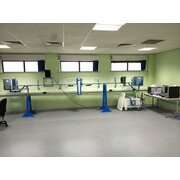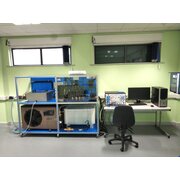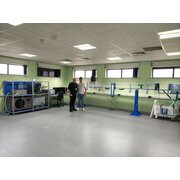Geothermal Training Systems & Lab Equipment
Sort by
Learn more about Geothermal Training Topics
In this section you will learn more about geothermal training systems. We cover whish types of training systems exists, how they are used in classrooms and training centers, trends, and benefits of using hands-on lab equipment.
What is Geothermal Training Equipment?
Geothermal training equipment refers to educational tools and systems designed to teach the principles and applications of geothermal energy. Geothermal energy harnesses heat from beneath the Earth's surface to generate electricity, provide heating, and offer cooling solutions.
Training equipment in this field allows students, engineers, and technicians to gain hands-on experience with geothermal systems, including the exploration of geothermal reservoirs, the design and operation of geothermal power plants, and the application of geothermal heat pumps for building climate control. These tools are essential for developing the skills needed to work in the geothermal energy sector, which is a key component of renewable energy strategies worldwide.
What Type of Geothermal Training Equipment Exists?
There are various types of geothermal training equipment, each focusing on different aspects of geothermal energy production and utilization:
Geothermal Power Plant Simulators:
Binary Cycle Power Plant Models: Simulate the operation of binary cycle geothermal power plants, which are commonly used in low to medium-temperature geothermal resources. These models help students understand the process of using a secondary fluid to generate electricity.
Flash Steam Power Plant Simulators: These tools mimic the operation of flash steam geothermal power plants, which utilize high-temperature geothermal resources to produce steam that drives turbines for electricity generation.
Geothermal Heat Pump Training Systems:
Ground Source Heat Pump Trainers: These systems demonstrate the principles of geothermal heat pumps, which use the stable temperatures of the ground to provide efficient heating and cooling for buildings. The trainers often include models of ground loops and heat exchange processes.
Direct Use Geothermal Systems: Equipment that simulates the direct use of geothermal energy for heating buildings, greenhouses, and industrial processes, focusing on the design and operation of systems that utilize low-temperature geothermal resources.
Geothermal Reservoir Simulation Tools:
Reservoir Modeling Software: Provides a virtual environment for simulating the behavior of geothermal reservoirs, allowing users to study heat extraction, fluid flow, and reservoir depletion over time.
Thermal Conductivity and Gradient Test Equipment: Hands-on tools for measuring the thermal properties of rocks and soils, crucial for assessing geothermal potential and designing effective systems.
Geophysical and Geochemical Analysis Equipment:
Seismic and Magnetotelluric Survey Kits: These are used to teach the methods of subsurface exploration, which are essential for locating geothermal resources. They help students understand how to interpret geophysical data to assess geothermal potential.
Geochemical Sampling and Analysis Tools: Equipment that allows for the sampling and chemical analysis of geothermal fluids, helping students learn about the composition of geothermal resources and their impact on system design and operation.
Well Drilling and Completion Models:
Drilling Simulation Systems: These simulators provide an understanding of the drilling techniques used to access geothermal reservoirs, including the challenges of drilling in high-temperature environments.
Well Logging and Completion Tools: Equipment used to simulate the logging and completion of geothermal wells, teaching students how to gather and interpret data on well conditions and to ensure effective heat extraction.
Environmental Impact and Monitoring Systems:
Emission Monitoring Tools: Equipment that simulates the monitoring of emissions from geothermal power plants, helping students understand the environmental impacts of geothermal energy production and the importance of emission control.
Environmental Impact Assessment (EIA) Software: Tools for evaluating the potential environmental effects of geothermal projects, teaching students to assess and mitigate risks associated with geothermal development.
Why Use Geothermal Training Equipment?
Geothermal training equipment is essential for several reasons:
-
Practical Skill Development: These systems provide hands-on experience that is crucial for developing the technical skills needed to design, operate, and maintain geothermal systems.
-
Understanding Complex Systems: Geothermal energy systems involve complex interactions between geology, thermodynamics, and engineering. Training equipment helps break down these complexities, making them easier to understand and apply in real-world scenarios.
-
Preparation for Industry Needs: The geothermal energy sector requires a workforce skilled in specialized techniques and technologies. Training equipment prepares students and professionals to meet the demands of this industry, enhancing their employability and effectiveness.
-
Innovation and Research: Geothermal training systems support research and development by providing platforms for testing new technologies and improving existing methods. This fosters innovation in geothermal energy applications.
-
Sustainability and Environmental Stewardship: Geothermal energy is a sustainable and low-emission energy source. Training on geothermal systems promotes awareness of sustainable energy practices and the environmental benefits of geothermal energy.
Best Practices for Using Geothermal Training Equipment
To maximize the benefits of geothermal training equipment, it's important to follow these best practices:
-
Comprehensive Curriculum Integration: Ensure that geothermal training equipment is integrated into a well-rounded curriculum that covers both the theoretical and practical aspects of geothermal energy. This alignment helps students gain a complete understanding of the subject.
-
Safety Emphasis: Geothermal systems can involve high temperatures and pressures. Proper safety training is essential to prevent accidents and to ensure that students and technicians can work safely with geothermal equipment.
-
Hands-On Practice: Encourage active, hands-on use of the training equipment to build confidence and competence in operating and troubleshooting geothermal systems. Practical experience is key to mastering geothermal technologies.
-
Regular Maintenance and Calibration: Keep the training equipment well-maintained and calibrated to ensure accurate simulations and reliable operation. Regular updates to the software and hardware ensure the training remains relevant and effective.
-
Scenario-Based Training: Use real-world scenarios to train students and professionals in responding to different geothermal conditions, such as varying resource temperatures, reservoir depletion, or system failures. This approach enhances problem-solving skills and prepares learners for field challenges.
-
Environmental and Economic Analysis: Encourage students to evaluate both the environmental and economic aspects of geothermal projects. This holistic approach helps them understand the broader impact and viability of geothermal energy.
-
Collaboration with Industry: Work with industry partners to ensure that training is relevant to current technological and market needs. This collaboration can also provide opportunities for internships, job placements, and industry-specific research projects.
-
Continuous Learning and Adaptation: Stay updated with the latest advancements in geothermal technology and integrate new developments into the training program. This ensures that learners are prepared for the evolving challenges and opportunities in the geothermal sector.
By adhering to these best practices, institutions and companies can effectively use geothermal training equipment to educate and prepare the next generation of engineers, technicians, and scientists for the growing field of geothermal energy.






